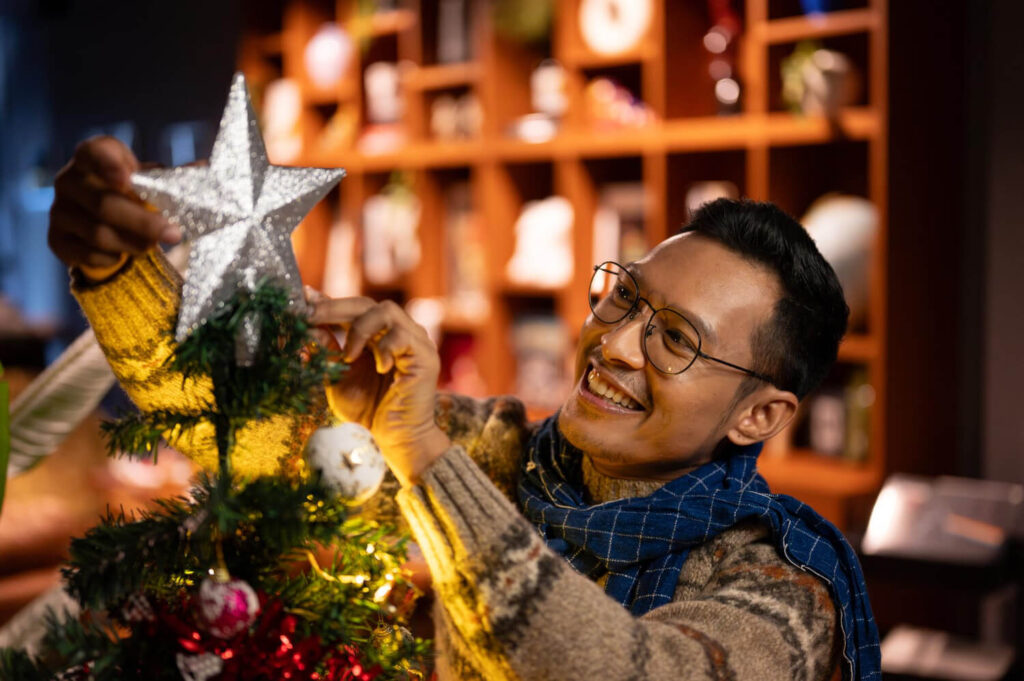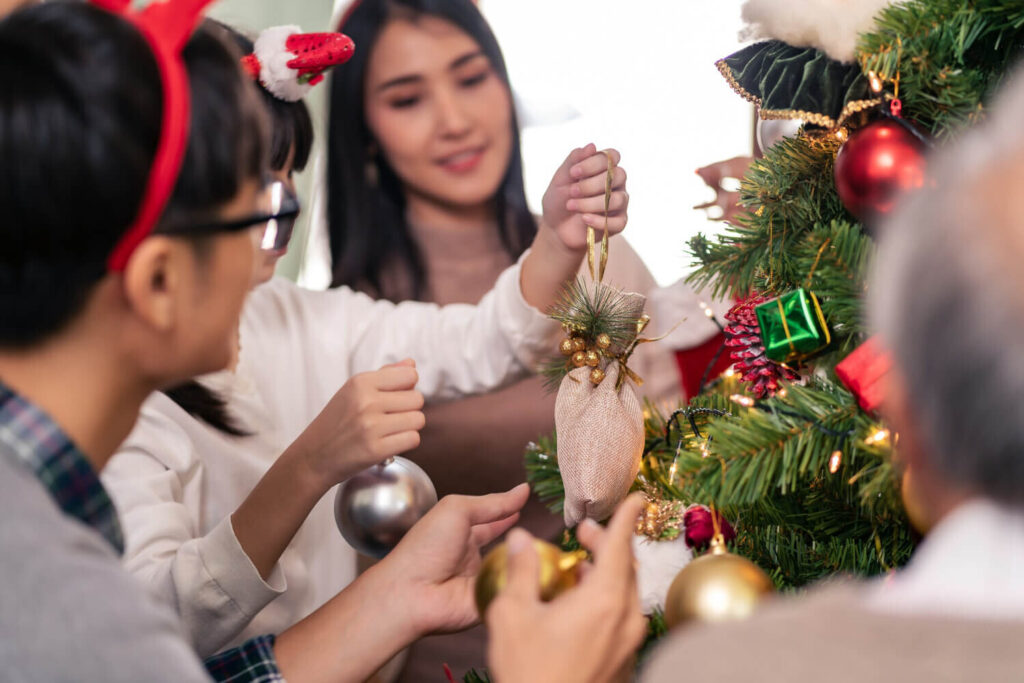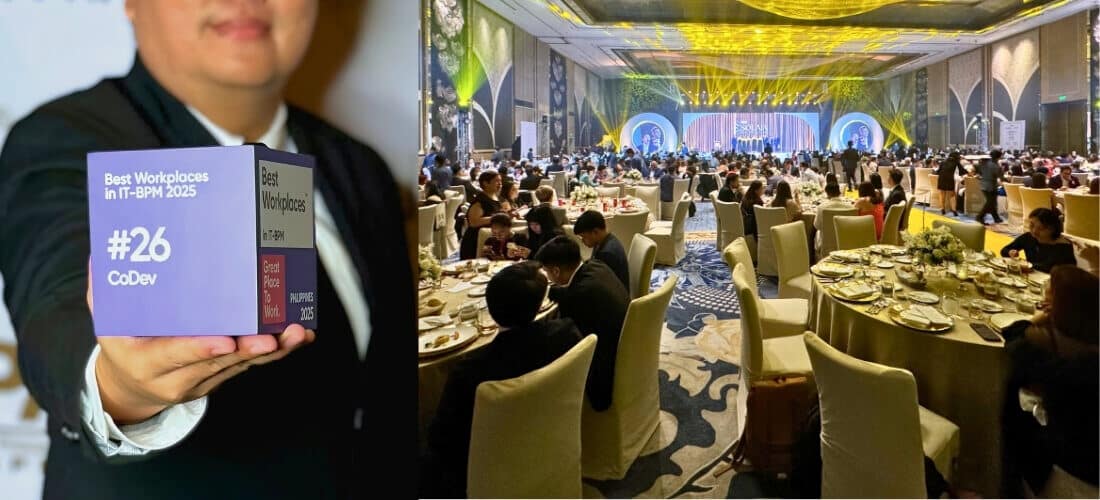12 Unique Traditions That Make Christmas in the Philippines One-of-a-Kind

Are you curious to learn how Filipinos celebrate Christmas in the Philippines?
At CoDev, we understand that Christmas in the Philippines is a joyous and festive celebration. It’s not just a holiday to celebrate for many Filipinos, but a tradition that embodies the spirit of being Filipino. If you have Filipinos on your offshore team, you probably know about some of these unique traditions.
Read below to discover the top 12 unique traditions during Christmas in the Philippines.
1. Longest Christmas celebration in the world.
Yes, you read that right. According to CNBC, the Philippines celebrate four months of Christmas, beginning in September. The longest in the world!
Filipinos start to have the Christmas spirit as early as September. Also known as the ‘ber’ months from September to December, decorations and festivities ramp up during these next four months. You’ll see many Filipinos do their Christmas shopping and party preparations early to beat the Christmas rush.
Compared to some Western countries, Christmas in the Philippines is mainly celebrated as a religious festival. As a result of Spanish colonization, the Philippines boasts of being the only Christian country in Asia, with more than 86% of the population being Roman Catholic. You can add another 2% of Filipinos being Protestant Christians.
Besides the religious fervor, Filipinos are known for their deep sense of community and love for celebration. Across the country, nearly every month brings a lively fiesta. Towns and provinces come alive with shared meals, colorful costumes, and vibrant street performances highlighting rich traditions and culture.
These festivities all contribute to a celebration that lasts for a few months.
2. Christmas in the Philippines is about Jesus.
As we said earlier, Filipinos view Christmas as a religious celebration in the Philippines. More than just about gift-giving and discounted shopping, it’s a time to celebrate the coming of the Messiah Jesus.
Many places in the country, including malls, offices, and homes, are decorated with statues of the ‘Nativity.’ The Nativity is a depiction of the birth of Jesus in the manger. Aside from that, Christmas in the Philippines isn’t complete with visiting church buildings with friends and family, but more later.
3. Mariah Carey can’t beat this Christmas song from the Philippines.
Instead of Mariah Carey’s All I want for Christmas Is You, Filipinos embrace another tune during the holiday season.
Christmas in Our Hearts by Jose Mari Chan is widely considered one of the greatest Christmas Hits for Filipinos. We know that “I... don't want a lot for Christmas.” is sung worldwide. However, Filipinos start with “Whenever I see girls and boys selling lanterns on the streets.”
The hit song, composed by Jose Mari Chan, was released in 1990 and featured his daughter, Liza Chan. It’s become an anthem for the nation during Christmas time. The song's lyrics beautifully capture the essence of love, peace, and joy, embodying the true spirit of Christmas. It reminds Filipinos to carry these values during the holiday season and year-round. Its uplifting melody and sing-along charm have made it a timeless favorite in Christmas celebrations across the Philippines.
Christmas in Our Hearts holds a cherished place in the hearts of many Filipinos. Synonymous with the start of the Christmas season, it fills homes, malls, and radio stations as early as September. This marks the beginning of the country’s famously long and festive holiday celebration.
4. Completing the nine dawn masses.
This tradition is highly anticipated since almost 90% of Filipinos are Christians. Known as Simbang Gabi, or Misa de Gallo in Spanish, is when Filipinos attend a series of nine night masses from December 16 to 24.
Simbang Gabi is one of the most cherished Christmas traditions in the Philippines. It is rooted in their deep Catholic faith and cultural heritage.
Simbang Gabi translates to "Night Mass," while Misa de Gallo means "Mass of the Rooster," referring to the early morning practice of celebrating these masses at dawn when the roosters crow. Traditionally, if one were to complete attending the nine masses, it’s said that you can have any wish granted.
The night masses date back to Spanish colonial times in the 17th century. Farmers and fishermen requested that church leaders hold masses before sunrise to allow them to attend before heading to work. Over time, this pre-dawn devotion evolved into a sacred spiritual practice and a symbol of anticipation and preparation for Christmas. It reflects the Filipino people's deep religiosity, as they dedicate nine consecutive days to prayer, thanksgiving, and reflection during the Advent season.
Simbang Gabi is more than just a religious tradition—it's a cultural emblem that captures the Filipino spirit of hope, faith, and community. It reflects how deeply interwoven faith and culture are in the Philippines, making Christmas a season of spiritual preparation and collective joy.
5. Filipinos prepare specific dishes for Christmas.
Food is at the heart of Filipino Christmas celebrations, with festive dishes that unite families and friends. The highlight is the Noche Buena, a grand feast enjoyed after midnight mass on Christmas Eve. This table often includes lechon (roast pig), hamón (glazed ham), and quezo de bola (round Edam cheese), alongside crowd-favorites like sweet Filipino spaghetti, morcon or embutido (stuffed meat rolls), and creamy fruit salad. These dishes symbolize abundance, joy, and togetherness during the season.
Traditional treats like bibingka (rice cake with salted egg) and puto bumbong (purple rice delicacy) are also a Christmas staple, especially after Simbang Gabi masses. Paired with warm drinks like tsokolate (Filipino hot chocolate) or salabat (ginger tea), these Christmas delicacies embody the warmth and comfort of the holidays.
Beyond the food, Christmas in the Philippines reflects a spirit of sharing, as families often prepare extra portions to share with neighbors or those in need, embodying the Filipino value of bayanihan (coming together as one).
6. Filipinos love to build lanterns during Christmas.

The parol, a star-shaped lantern, is one of the most iconic symbols of Christmas in the Philippines. Inspired by the Star of Bethlehem, the parol represents light, hope, and the Filipino spirit of togetherness. Traditionally made from bamboo and colorful paper, these lanterns adorn homes, streets, and churches across the country during the holiday season, creating a festive and heartwarming atmosphere.
The parol has a rich history, originating in the Spanish colonial era when it was used to light the way to early morning Simbang Gabi masses. Over time, it evolved into a decorative and cultural symbol, with designs ranging from simple handmade lanterns to elaborate creations illuminated by LED lights. Regardless of their complexity, parols embody the resourcefulness and creativity of Filipinos.
For many, the parol is a cherished tradition. Families often craft lanterns together, while communities host parol-making contests to celebrate their shared heritage. This beloved symbol captures the Filipino Christmas spirit's warmth, resilience, and hope.
7. Never-ending caroling.
You can always expect Filipinos to love singing. Caroling is a beloved and enduring Christmas tradition in the Philippines, filling neighborhoods and streets with joyful melodies throughout the holiday season. Starting as early as December 1, children and adults form small groups and go house to house singing classic Filipino and English Christmas songs, sometimes accompanied by makeshift instruments like tambourines made from bottle caps or drums crafted from tin cans.
The spirit of caroling is rooted in fun and community. After each performance, carolers are rewarded with coins, small treats, or sometimes even snacks. While many carolers sing for joy, others use it to raise funds for church groups, schools, or charities, embodying the Filipino spirit of bayanihan (community helping each other).
Caroling in the Philippines often lasts well beyond Christmas Day, with groups continuing to spread cheer into the New Year. This never-ending caroling reflects the Filipinos’ deep love for music and celebration, making the season feel even more alive with festive energy.
8. Filipinos celebrate Noche Buena, not Boxing Day.
The highlight of Christmas is Noche Buena, a grand family feast celebrated on Christmas Eve, unlike the Boxing Day traditions observed in other countries. After attending midnight mass, families come together to share a lavish meal filled with festive dishes like lechon (roasted pig), hamón (glazed ham), quezo de bola (Edam cheese), and sweet Filipino spaghetti. It’s a joyful time of bonding, gratitude, and indulgence in food that symbolizes abundance and love.
Unlike Boxing Day, which is focused on post-Christmas sales and giving gifts to service workers, Noche Buena centers on togetherness and the Filipino value of pagkakasama (being together). It’s a night when even far-away family members try to return home, strengthening relationships and celebrating the true spirit of Christmas.
9. The vital roles of Ninong and Ninang.

Ninong (godfather) and Ninang (godmother) play a significant role in Christmas traditions and Filipino culture. These chosen individuals serve as spiritual mentors and second parents to their inaanak (godchildren), fostering a bond beyond the holiday season. Their responsibilities include guiding their godchildren in faith and values and supporting them throughout their lives.
During Christmas in the Philippines, the role of ninongs and ninangs takes center stage. It’s customary for inaanak to visit their godparents to express their gratitude and love, often receiving gifts, cash, or tokens in return. This exchange symbolizes generosity, family bonds, and a sense of community in Filipino culture.
For ninongs and ninangs, the holiday season is a time to give and reconnect and strengthen relationships with their godchildren. This unique Filipino tradition highlights the importance of mentorship, family, and generosity during the most festive time of the year.
10. Christmas parties are everywhere, from the smallest neighborhoods to malls.
Christmas parties and festivities happen everywhere in the Philippines, making the season genuinely unforgettable. From the smallest neighborhoods (barangays) hosting gatherings to schools to the biggest malls dazzling with elaborate decorations and events, the holiday spirit is impossible to miss.
Friend groups and families also join in the celebration, hosting reunions, potluck dinners, and gift exchanges, highlighting the importance of togetherness. Whether it’s a simple street party or a grand celebration in a city plaza, the Filipino love for festivities shines through, turning every corner into a joyful holiday scene.

11. Belen displays everywhere.
Belen (nativity scenes) are a cherished Christmas tradition, symbolizing the birth of Jesus Christ. The Belen is often displayed prominently in homes, offices, and public spaces. The Belen showcases the Holy Family—Mary, Joseph, and the infant Jesus—and other figures such as the shepherds, angels, and the Three Kings.
Filipino Belen displays are known for their creativity and intricate details. Some are simple and handmade, while others are elaborate and grand, with life-sized figures, flowing streams, and beautiful lighting. You may find Belen contests in larger cities or parishes, where communities compete to create the most beautiful nativity scene. In these contests, it’s common to see modern interpretations of the Belen, blending traditional religious figures with Filipino elements, such as using local materials like bamboo, nipa palm, or indigenous textiles to craft the figures.
Aside from their religious significance, Belens serve as a unifying tradition, bringing families and communities together to reflect on the values of love, hope, and humility during Christmas. Many Filipinos take great pride in crafting their own Belen, often as part of a family activity that fosters togetherness. This tradition expresses faith and is a way to preserve Filipino cultural identity during the holidays.
12. The Christmas bonus and 13th month pay.
The Christmas bonus and 13th-month pay are important holiday traditions that provide financial relief and joy to employees during the festive season. These bonuses are mandated by law and are a key part of Filipino Christmas celebrations, helping families enjoy the holiday without the financial stress that often accompanies the season.
The 13th month pay is a statutory benefit employers must give employees, usually released in December. It’s calculated as 1/12th of an employee’s total salary earned during the year, significantly boosting income during the holiday season. This extra pay is widely anticipated, as it allows families to purchase gifts, host parties, or pay for holiday expenses.
Although not mandatory, the Christmas bonus is standard in many companies. It can vary in amount, often depending on the company’s performance and policies.
For employees, the 13th-month pay and the Christmas bonus ease the financial burden of Christmas shopping, attending parties, and visiting family.
Christmas at CoDev Philippines
Filipino Christmas traditions blend faith, family, and festivity, reflecting the country's values and joyful spirit.
From Simbang Gabi and Noche Buena to parols and caroling, these customs bring communities together in celebration. Unique practices like the belen displays, parol making, and the much-anticipated 13th-month pay highlight Filipino culture's heartwarming and generous nature. Overall, this makes Christmas in the Philippines genuinely one-of-a-kind!
Are you looking to build a Filipino offshore team to grow your company? Book a free consultation now to learn how you can do it!




